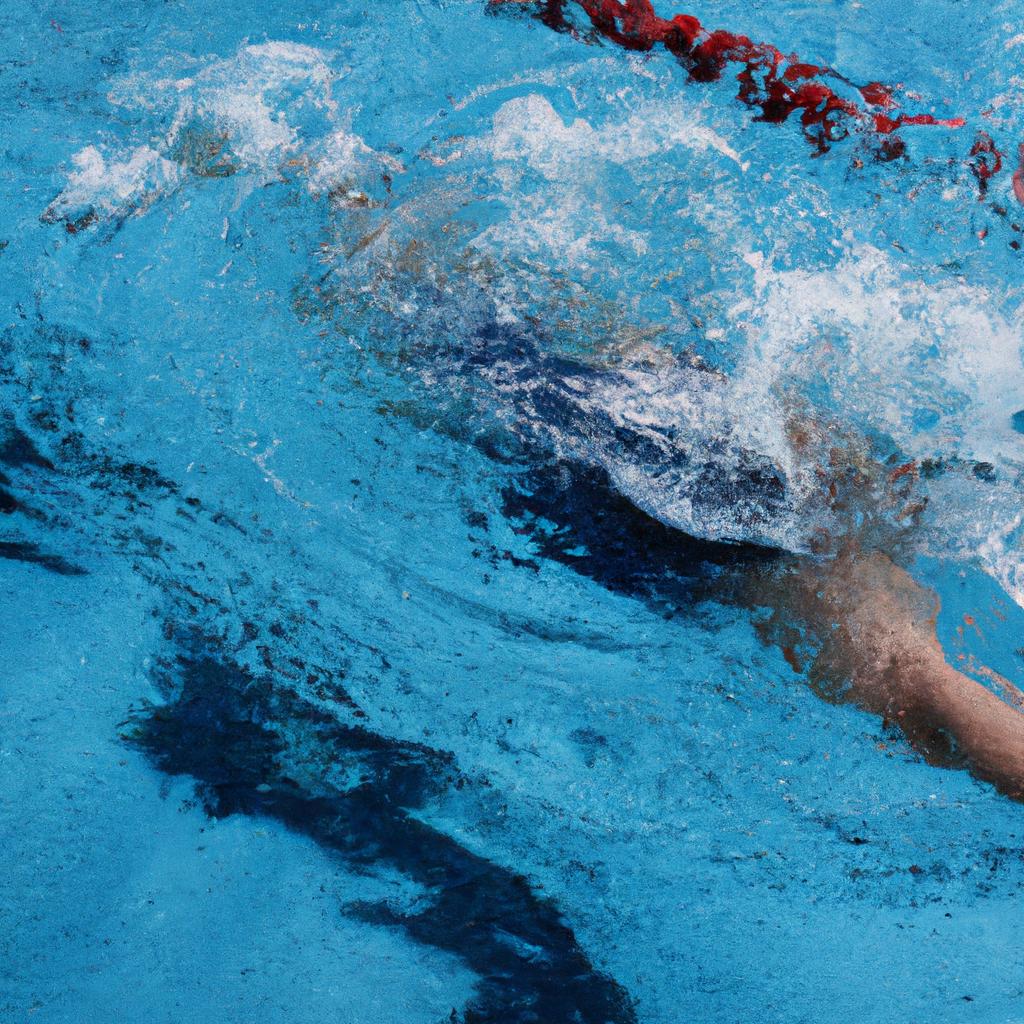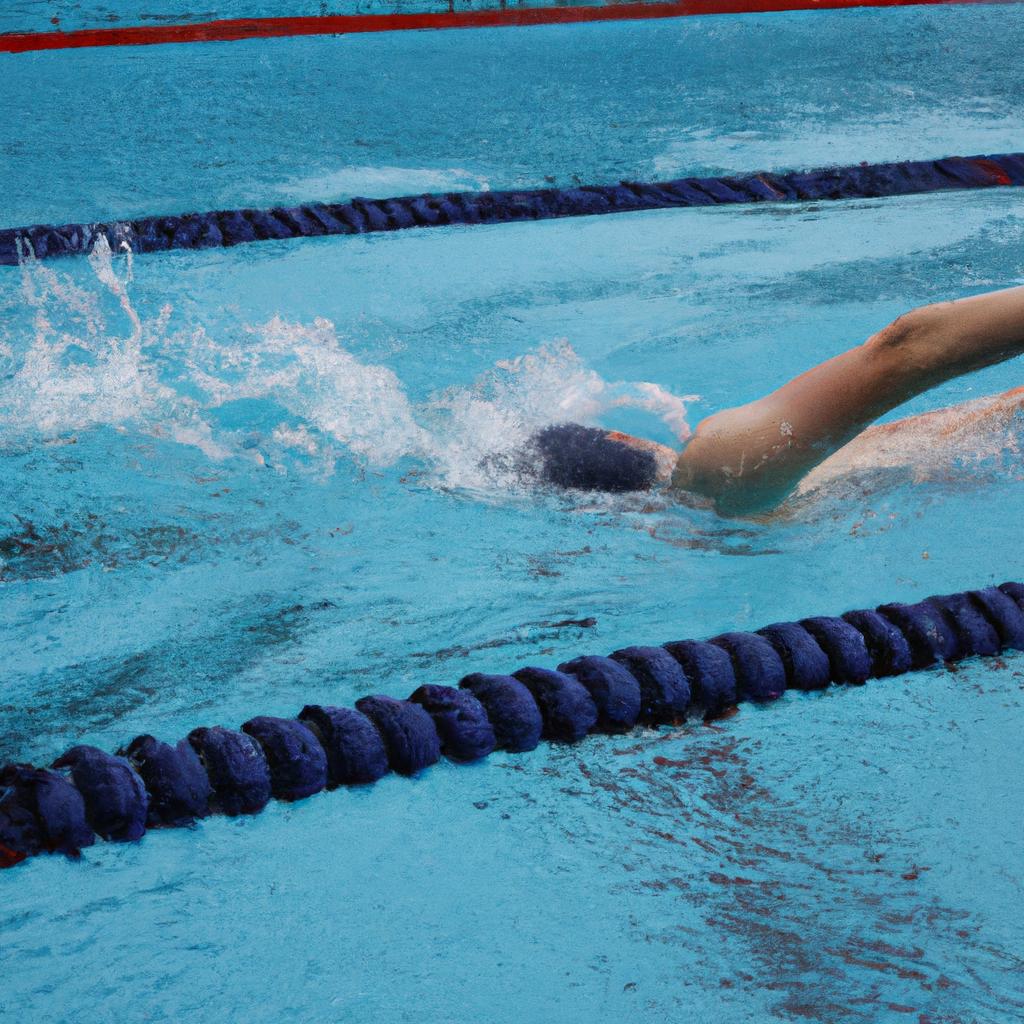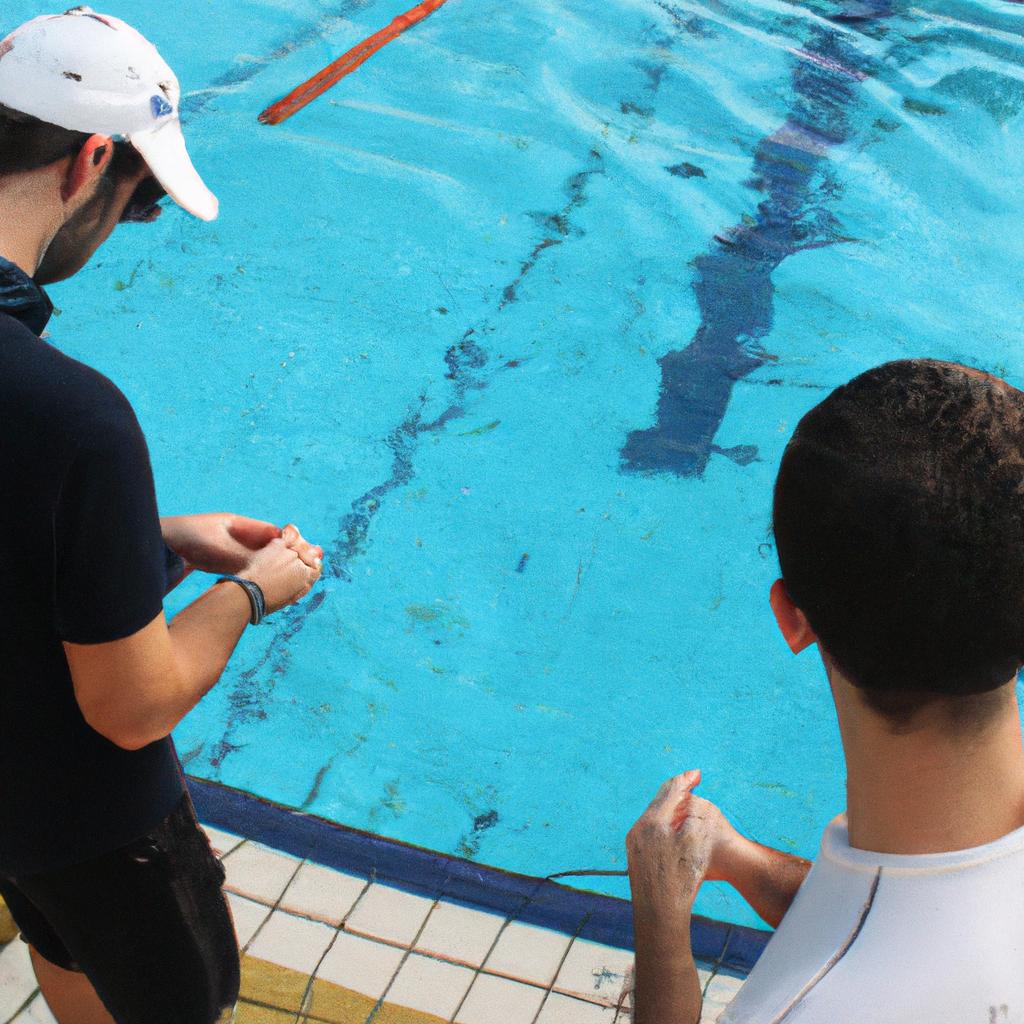Competitions and Meets: Swim & Tennis Club’s Swim Team
Imagine a group of determined swimmers, clad in vibrant swim caps and sleek swimsuits, eagerly diving into the crystal blue waters of a swimming pool. They glide effortlessly through the water, their synchronized movements showcasing years of training and dedication. This scenario is not merely hypothetical; it represents the competitive nature of swim meets that take place within the Swim & Tennis Club’s esteemed swim team. As one of the most accomplished aquatic teams in the region, this club offers its members an opportunity to participate in various competitions and meets throughout the year.
Swim meets serve as platforms for athletes to showcase their skills and measure themselves against fellow competitors from different clubs or schools. These events provide an environment for testing both individual ability and collective teamwork, fostering personal growth alongside camaraderie among teammates. For instance, during last year’s regional championship meet, Swim & Tennis Club’s swim team demonstrated exceptional performance by securing numerous podium finishes across various age categories. The intense preparation leading up to such events involves rigorous training regimens under professional coaches who focus on refining techniques, improving endurance, and nurturing mental resilience – all essential elements for success at these highly competitive meets.
In this article, we will delve deeper into understanding the different types of swim meets and competitions that the Swim & Tennis Club’s swim team participates in, as well as the benefits and challenges associated with these events.
The Swim & Tennis Club’s swim team actively competes in a range of swim meets and competitions throughout the year. These include local invitational meets, regional championships, state-level competitions, and even national-level events for those swimmers who qualify. Each type of meet offers its own unique set of challenges and opportunities for swimmers to showcase their skills.
Local invitational meets are usually held within the community and allow swimmers from various clubs or teams to come together for friendly competition. These meets serve as excellent learning experiences for younger or less experienced swimmers, providing them with an opportunity to gain exposure to competitive swimming while building confidence in a supportive environment.
Regional championship meets take place on a larger scale, bringing together swimmers from different clubs or schools within a specific geographic region. These events often feature fierce competition among top-level athletes vying for podium finishes and qualification spots for higher-level competitions. Regional championships provide swimmers with an opportunity to gauge their progress against other top performers in the area while representing their club or team with pride.
State-level competitions elevate the intensity even further, as they bring together the best swimmers from across the entire state. These highly prestigious events require exceptional performance levels and often serve as qualifiers for national-level competitions. Swimmers who excel at state championships may have the chance to compete against some of the country’s most talented athletes at prominent national swim meets.
Participating in these various swim meets and competitions offers numerous benefits to members of the Swim & Tennis Club’s swim team. Firstly, it provides them with valuable experience competing under pressure, honing their ability to perform at their best when it matters most. Additionally, these events foster a sense of camaraderie among teammates as they work towards shared goals and support each other through both victories and setbacks.
However, it’s important to acknowledge the challenges associated with swim meets as well. The demanding training schedules leading up to these events can be physically and mentally taxing for athletes. They require a high level of commitment, discipline, and sacrifice in terms of time and energy. Swimmers must balance their academic responsibilities, social lives, and other commitments alongside their rigorous training regimens to excel in both the pool and other areas of life.
In conclusion, swim meets and competitions play a vital role in the Swim & Tennis Club’s swim team’s journey towards excellence. These events offer opportunities for swimmers to test their skills, measure their progress against competitors from different clubs or schools, and showcase their abilities on various levels. While challenging, participating in swim meets provides invaluable experiences that foster personal growth, teamwork, and lasting memories for all involved.
History of the club’s swim team
The swim team at the Swim & Tennis Club has a rich history that spans over several decades. To understand its evolution, let us consider an example: Sarah, a young and passionate swimmer, joined the club’s swim team in 1995.
Over the years, the swim team has grown steadily in terms of membership and achievements. One reason for this growth is the emphasis on fostering a competitive yet supportive environment. This encourages athletes like Sarah to push their limits and improve their skills through rigorous training sessions and regular competitions.
To illustrate further, here are some key aspects that have contributed to the success of the swim team:
- Dedicated coaching staff: The club has always prioritized hiring experienced coaches who not only possess technical expertise but also motivate swimmers to reach their full potential.
- State-of-the-art facilities: The Swim & Tennis Club takes pride in providing top-notch swimming facilities that include Olympic-sized pools and advanced training equipment.
- Team camaraderie: A strong sense of unity among team members creates an atmosphere where they can rely on each other for support and encouragement during challenging times.
- Community involvement: The club actively engages with parents and sponsors local events, which fosters a strong community spirit among both swimmers and non-swimming members.
Through these efforts, the Swim & Tennis Club’s swim team has become renowned for its exceptional performance in various regional and national competitions.
In considering the history of the club’s swim team, it becomes evident that participating in such an esteemed program offers numerous benefits beyond mere athletic achievement. In the following section, we will explore how being part of this competitive environment positively impacts individual swimmers’ personal development and overall well-being.
Benefits of participating in swim meets
Building upon its rich history, the Swim & Tennis Club’s swim team actively participates in various competitions and meets. These events provide an opportunity for swimmers to showcase their skills, compete against other teams, and achieve personal growth. By engaging in these experiences, participants not only enhance their abilities but also develop valuable life skills that extend beyond the pool.
Competing at swim meets is a crucial aspect of the club’s swim team experience. For instance, let us consider a hypothetical case study involving Emily, a dedicated member of the swim team. Emily spent months honing her technique under the guidance of experienced coaches at the club. When she finally participated in her first meet, she felt a mix of excitement and nervousness. As she stood on the starting block alongside competitors from different clubs, adrenaline surged through her veins. This intense environment pushed her to perform better than ever before, exceeding even her own expectations.
Participating in swim meets offers numerous benefits for young athletes. It fosters discipline by prompting swimmers to adhere to rigorous training schedules and maintain healthy lifestyles. Additionally, it cultivates self-confidence as individuals witness their progress over time and receive recognition for their achievements. Furthermore, competing allows swimmers to develop mental resilience as they learn how to handle pressure and adversity effectively.
To highlight some key advantages more explicitly:
- Enhanced Physical Fitness: Regular participation in swim meets contributes to improved endurance, strength, flexibility, and overall fitness.
- Social Interaction: Swimmers have opportunities to build friendships with teammates while fostering sportsmanship by interacting with rivals during competitions.
- Goal Setting: Competing provides motivation for setting performance goals and working diligently towards achieving them.
- Time Management Skills: Balancing academic commitments with intensive training sessions teaches swimmers valuable time management skills essential for success both inside and outside of swimming.
In addition to these personal benefits, swim meets also contribute to the broader swimming community. They serve as platforms for coaches and swimmers from various teams to share knowledge, exchange ideas, and promote camaraderie. Through healthy competition and mutual support, participants collectively elevate the level of performance in the sport.
As members of the Swim & Tennis Club’s swim team continue their journey towards excellence, it becomes crucial to explore different types of swim competitions. Understanding these variations will provide a comprehensive view of the opportunities available within this vibrant realm of competitive swimming.
Transition into subsequent section:
By delving into an exploration of different types of swim competitions, we can deepen our understanding and appreciation for the diverse landscapes that exist within this dynamic sporting domain.
Different types of swim competitions
The Benefits of participating in swim meets have been discussed, now let’s delve into the different types of swim competitions that participants can engage in. To illustrate this, let’s consider a hypothetical scenario involving the Swim & Tennis Club’s Swim Team.
Swim meets come in various forms, each with its unique structure and challenges. The Swim & Tennis Club’s Swim Team regularly participates in four main types of competitions:
-
Dual Meets: These are matches where two teams compete against each other. They provide an opportunity for swimmers to showcase their skills in a more intimate setting. It fosters camaraderie among teammates as they work together towards a collective goal – victory for their team.
-
Invitational Meets: As the name suggests, these events invite multiple teams from different clubs or schools to participate. This broader competition allows swimmers to gauge their abilities against a wider range of opponents, offering valuable experience and exposure to different swimming styles.
-
Championship Meets: Typically held at the end of a season, championship meets bring together top-performing swimmers from various clubs or regions. These high-stakes competitions push athletes to excel under pressure and offer the chance to qualify for higher-level tournaments.
-
Open Water Races: Unlike pool-based contests, open water races take place in natural bodies of water such as lakes or oceans. Participants brave the elements and navigate through longer distances while contending with currents and unpredictable conditions—a true test of endurance and adaptability.
These diverse competitions not only challenge swimmers physically but also foster personal growth and development by promoting discipline, perseverance, and resilience—the very qualities that help individuals thrive both inside and outside the pool.
To further understand the differences between these competitions, refer to the following table:
| Competition Type | Description | Key Features |
|---|---|---|
| Dual Meets | Matches between two teams | Emphasizes team dynamics and unity |
| Invitational Meets | Multi-team events | Provides exposure to diverse opponents |
| Championship Meets | High-stakes competitions | Opportunity for qualification |
| Open Water Races | Swimming in natural bodies of water | Demands endurance and adaptability |
With an understanding of the various types of swim competitions, participants can now explore how to prepare effectively for these challenges. Transitioning into the next section, let’s delve into “How to Prepare for a Swim Meet” to ensure swimmers are ready to give their best performance.
How to prepare for a swim meet
Having explored the different types of swim competitions, let us now delve into how swimmers can effectively prepare for a swim meet. To illustrate this process, we will consider the case of Olivia, an aspiring swimmer who is preparing for her first major competition.
Paragraph 1:
Olivia recognizes that adequate physical preparation is crucial to performing well in a swim meet. In order to enhance her speed and endurance, she engages in regular training sessions at the Swim & Tennis Club’s pool. Additionally, she focuses on improving her technique through targeted drills and practice sets. By consistently attending coaching sessions and implementing feedback from experienced trainers, Olivia aims to refine her strokes and turns, ultimately optimizing her performance during the meet.
Paragraph 2:
Apart from physical preparation, mental readiness plays a vital role in achieving success at a swim meet. Olivia practices visualization techniques wherein she imagines herself confidently executing each race with precision. This helps build her self-belief and enhances focus during intense moments of competition. Furthermore, she adopts relaxation strategies such as deep breathing exercises to manage pre-race jitters and maintain composure throughout the event.
To ensure comprehensive preparation for a swim meet, swimmers like Olivia should consider:
- Establishing achievable goals for each race
- Maintaining proper hydration levels leading up to the competition
- Adhering to a balanced diet rich in nutrients
- Getting sufficient rest and sleep before the day of the meet
Paragraph 3 (with table):
Furthermore, swimmers must be mindful of their equipment requirements prior to competing in a swim meet. The following table highlights some essential items they need to bring along:
| Item | Purpose | Importance |
|---|---|---|
| Swimsuit | Provides hydrodynamics | Ensures optimal performance |
| Goggles | Protects eyes from chlorine irritation | Enhances visibility |
| Swim cap | Reduces drag in the water | Promotes streamlined swim |
| Towel | Dries off after races | Provides comfort |
Understanding how to effectively prepare for a swim meet is crucial, but equally important is recognizing the significance of teamwork in such competitions. In the subsequent section, we will explore how collaboration and support among teammates can contribute to success.
[Note: The next section about “Importance of teamwork in swim competitions” should directly follow this transition.]Importance of teamwork in swim competitions
Transitioning from the previous section on how to prepare for a swim meet, it becomes evident that teamwork plays a crucial role in swim competitions. For instance, consider an imaginary scenario where a swim team is participating in a relay race. Each member of the team needs to synchronize their movements and timing with one another to achieve success. This example highlights the importance of teamwork within the context of competitive swimming.
Teamwork in swim competitions can significantly impact overall performance. Here are some key aspects highlighting its significance:
- Collaboration: Working together as a cohesive unit allows swimmers to share insights, strategies, and experiences. This collaboration fosters trust and respect among team members, leading to enhanced cooperation during races.
- Motivation: Teammates cheering each other on during competitions can provide motivation and encouragement when facing challenges or fatigue. The emotional support received from teammates has been proven to positively influence individual performances.
- Division of labor: In relays or group events like synchronized swimming, tasks are divided among team members according to their strengths and abilities. This distribution ensures that every aspect of the competition is executed efficiently.
- Learning opportunities: By observing fellow teammates’ techniques and approaches, athletes can learn new skills or refine existing ones. These learning opportunities contribute not only to personal growth but also strengthen the entire team’s performance.
To further illustrate this point, let us examine a table showcasing different elements of teamwork in swim competitions:
| Element | Description | Emotional Response |
|---|---|---|
| Communication | Effective communication between teammates improves coordination | Sense of unity |
| Trust | Trusting teammates enables individuals to take calculated risks | Feeling supported |
| Supportiveness | Offering assistance and encouragement enhances morale | Encouragement |
| Cooperation | Collaborating towards shared goals promotes camaraderie | Shared sense of accomplishment |
In conclusion, teamwork plays an integral role in achieving success in swim competitions. Through collaboration, motivation, division of labor, and learning opportunities, swimmers can enhance their individual performances while contributing to the overall team’s success. In the upcoming section on “Tips for improving performance in swim meets,” we will delve into specific strategies that can further maximize individual and team achievements during competitions.
Tips for improving performance in swim meets
Building upon the significance of teamwork in swim competitions, it is now crucial to explore ways to enhance individual performance during swim meets. By focusing on personal improvement and employing effective strategies, swimmers can strive for excellence and maximize their potential.
To better understand how these tips can be applied, let’s consider a hypothetical case study. Meet Sarah, an aspiring competitive swimmer who has been training diligently for months. Despite her dedication, she often finds herself struggling to achieve her desired results during swim meets. Through a series of deliberate adjustments and targeted techniques, Sarah manages to overcome her obstacles and significantly improve her performance.
- Mental Preparation:
- Visualize success: Before each meet, visualize yourself executing flawless strokes and achieving your goals.
- Positive self-talk: Encourage yourself with positive affirmations such as “I am strong” or “I am capable.”
- Focus on process rather than outcome: Instead of fixating solely on winning, concentrate on performing to the best of your abilities.
- Physical Conditioning:
- Consistent training: Regularly attend practice sessions and follow a structured workout plan.
- Proper nutrition: Fuel your body with nutritious meals that support muscle growth and recovery.
- Sufficient rest: Ensure you get enough sleep to promote physical rejuvenation before important meets.
- Technique Refinement:
- Seek feedback from coaches or mentors: They can provide valuable insights into areas that need improvement.
- Video analysis: Record your swimming technique and analyze it carefully to identify any flaws.
- Work on specific skills or drills recommended by professionals within your chosen stroke discipline.
Table showcasing different types of swimming strokes:
| Stroke | Description |
|---|---|
| Freestyle | Uses alternating arm motion |
| Backstroke | Swimmer lies on their back |
| Breaststroke | Requires simultaneous leg kick |
- Goal Setting:
- Set specific, measurable, attainable, relevant, and time-bound (SMART) goals.
- Break down long-term objectives into smaller milestones to track progress effectively.
- Celebrate achievements along the way to maintain motivation.
By implementing these tips, swimmers like Sarah can enhance their performance in swim meets. However, it is important to remember that improvement takes time and consistent effort. Embracing a growth mindset and persevering through setbacks will ultimately lead to success in competitive swimming.
 Beverly Crest Swim
Beverly Crest Swim



